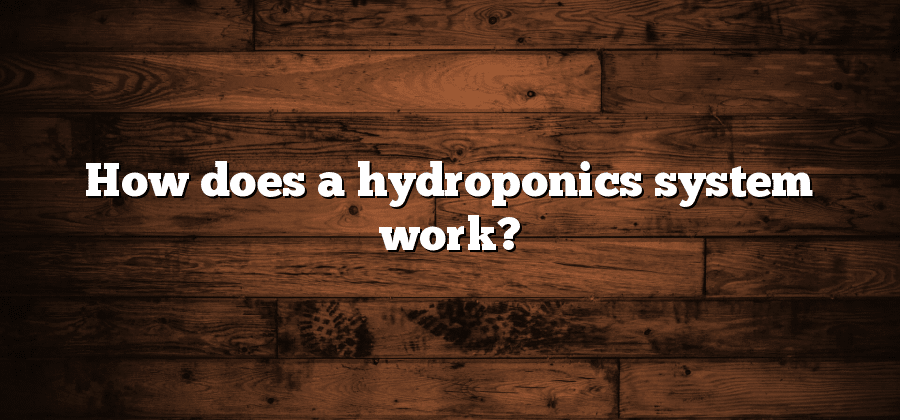Hydroponics System: Understanding the Basics
Hydroponics, a method of growing plants without soil, has gained significant popularity among both home gardeners and commercial growers. Understanding the basics of this system is essential for anyone interested in harnessing its potential benefits. In a hydroponics system, plants receive their required nutrients directly from a nutrient-rich water solution. Unlike traditional garden setups, hydroponics eliminates the need for soil, allowing plants to grow in a soilless medium.
One of the key components of a hydroponics system is the growing medium, which serves as a support system for the plants. Commonly used growing mediums include coconut coir, perlite, and vermiculite. These mediums provide stability for the plants, while also allowing the roots to access the nutrient solution. By carefully selecting the right growing medium, growers can ensure optimal plant growth and health. Additionally, a nutrient solution, containing essential minerals and nutrients, plays a crucial role in the success of a hydroponics system. This solution serves as the primary source of sustenance for the plants, replacing the nutrients that would typically be obtained from soil in traditional gardening methods.
Components of a Hydroponics System
When it comes to setting up your own hydroponics system, there are several key components that you’ll need to consider. One of the most important elements is the reservoir, which holds and delivers the nutrient solution to your plants. Typically made from plastic or another non-reactive material, the reservoir needs to be sturdy and capable of holding a sufficient volume of solution to meet your plants’ needs.
Another vital component is the grow tray or container, where you’ll place your plants. This can be made from various materials such as plastic, glass, or even PVC piping. It should be designed to provide adequate support for your plants and allow for proper drainage. Additionally, a pump is necessary to circulate the nutrient solution from the reservoir to the plants, ensuring they receive the necessary nutrients and oxygen. Choose a reliable and efficient pump that can suit the size and requirements of your hydroponic system. Lastly, you’ll need an air stone or diffuser to add oxygen to the nutrient solution, ensuring healthy root growth and preventing root rot. Keep in mind that each component of a hydroponics system must be carefully chosen and properly maintained to ensure optimal plant growth and productivity.
Benefits of Using a Hydroponics System
Hydroponics systems offer numerous benefits for modern-day growers. One of the key advantages is the ability to control the growing environment with precision. In traditional soil-based farming, it can be challenging to manage factors such as pH levels, nutrient content, and water availability. However, in hydroponics, growers have complete control over these variables, enabling them to optimize plant growth and productivity. This level of control also allows for a more efficient use of resources as water and nutrients can be recycled and reused within the system, minimizing waste and reducing overall consumption.
Another significant benefit of hydroponics is the ability to grow plants in limited space. Unlike conventional farming methods, which require large expanses of land, hydroponics systems can be set up in smaller areas, such as greenhouses or indoor facilities. This makes hydroponics particularly advantageous for urban environments or areas with limited access to arable land. Additionally, the controlled environment of hydroponics eliminates the need for pesticides and herbicides, resulting in healthier, more natural produce. By eliminating the need for soil, hydroponics systems also mitigate the risk of soil-borne diseases and pests, further enhancing crop quality and yield.
Selecting the Right Growing Medium
When it comes to hydroponic gardening, selecting the right growing medium is a crucial step towards ensuring the success of your plants. Unlike traditional soil-based gardening, hydroponics relies on a different type of medium that holds the roots of the plants and provides them with oxygen, water, and nutrients. The growing medium essentially acts as a substitute for soil, supporting the plants and facilitating their growth.
There are several options available for hydroponic growing mediums, each with its own advantages and disadvantages. Some of the most commonly used mediums include perlite, vermiculite, coconut coir, rockwool, and clay pellets. The choice of growing medium will depend on various factors such as the type of plants you are growing, the available resources, and your personal preferences. It is important to consider the water retention capacity, pH stability, and oxygenation properties of the medium when making your selection. Consulting with experienced hydroponic growers or conducting thorough research will help you make an informed decision and optimize your hydroponic system for success.
Nutrient Solution: The Key to Success
Nutrient solution is a vital component in the success of a hydroponics system. Unlike traditional soil-based gardening, hydroponics relies on a carefully balanced mix of nutrients dissolved in water to nourish the plants. These nutrients are essential for the plants to grow and thrive in a controlled environment.
A well-balanced nutrient solution must contain the primary macronutrients, such as nitrogen, phosphorus, and potassium, as well as secondary macronutrients like calcium, magnesium, and sulfur. In addition, micronutrients such as iron, manganese, zinc, and copper are also necessary for healthy plant growth. The concentration and ratios of these nutrients need to be carefully maintained to ensure optimal plant nutrition. Without a proper nutrient solution, plants may suffer from deficiencies or excesses, leading to stunted growth, nutrient burn, or even death. Therefore, understanding the composition and importance of a nutrient solution is crucial for achieving successful hydroponic gardening.






